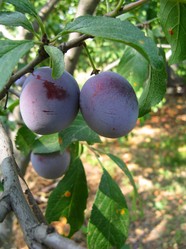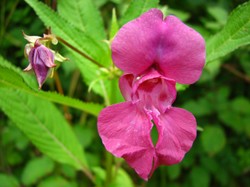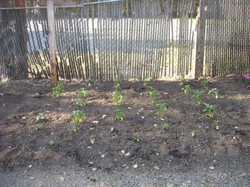Doing well, but in need of weeding would be the verdict. In this country, give us a period of reasonably heavy rain and the weeds go mad, taking advantage of the fact that there is less weeding done in rainy than in dry conditions. I have had a few good sessions recently getting the weeds up. You need a range of tools. I have just acquired a slasher, which is something like a machete but with a different, flattened blade at the end. I have scythe as well, but the slasher is better when working in confined spaces, near the fruit trees and on the paths. the scythe, though, can cut down more weeds in one stroke than the slasher can, so each has its use.
I am puzzled, though, and I am not the only one. Last year my peas were a disaster, strange after many years of success. This year the early sowings of peas were good, but the later one is poor and they are only just beginning to peep from the ground. But other gardeners on our plot have had the same experience over the past two years. No one knows why. But last year sweetcorn gave only a moderate crop, but mine is looking reasonably good this year, and that's promising, as North West England is not ideal sweet corn territory. It is too cold and damp. Last year parsnips did better than carrots, yet this year the carrot crop is looking good, but the parsnips less so.
There seems to be no consistent pattern in these facts. But this may be due to the fact that the weather seems to be more variable than before. The Spring season has been drier than normal, though last year we had a dry and very cold Spring, certainly worse than this one. Yet we are having a June of below average temperature.
We are on the alert. Cool, damp conditions are ideal for fungal attack. Potatoes can be attacked by blight, and so we have to spray them with Bordeaux mixture. I grow second early potatoes, which are not as liable to blight as main crop potatoes are, but I am still taking precautions and spraying. Also I am going to spray the plums with sulfur, a necessary anti-fungal application. We get trouble with fungal growth on plums, as the fungus likes the damper climate of the West of Britain more than the drier East. This time it is goggles and a face mask when spraying.for last year i sprayed without and the irritant dust blew back into my face. That was no fun!













 TheThousand Year Gardenon 11/26/2025
TheThousand Year Gardenon 11/26/2025
 Women of the Gospelson 10/11/2025
Women of the Gospelson 10/11/2025
 Religious Gardenson 08/25/2025
Religious Gardenson 08/25/2025
 Doctor of the Church: John Henry Newmanon 08/03/2025
Doctor of the Church: John Henry Newmanon 08/03/2025



Comments
Def8nitely a plus. It is flavoursome
Your comment below, in the second box down, on Feb. 3, 2016, intrigues me with its conclusion that "It is worth noting that in Cumbria, north of me, damsons are sometimes used by one brewer as an ale flavouring in place of hops."
Is the damson flavoring a minus or a plus?
I love damsons and I make damson jam. The stones can be a problem . I scoop them out whilst cooking the jam but we don't mind if a stone is in the jam; we just remove it whilst spreading it.
Damsons need a bit more sugar . My friends make damson gin which really "puts hair on your chest " .
Damsons and plums are the same species, but different varieties thereof, but damson is more tart than plum is, as Maritravel says. I used to visit Worcestershire [ England's great fruit growing region in the West Midlands] which is a hundred miles south of me, when my son lived there, and I noticed how well the damsons grew in the hedges, but the climate there is great for fruit.
It is worth noting that in Cumbria, north of me, damsons are sometimes used by one brewer as an ale flavouring in place of hops.
if you like tart fruits like blackcurrants and sharp apples like Bramleys you'll love damsons, and damson jam is fantastic.
I've never heard of a damson tree! Thanks for introducing me.
Ah, I didn't spread the roots out. Thank you - a job for tomorrow. I have given it a good feed of manure so I'll keep my fingers crossed for a few damsons this coming year.
It hasn't been in a sheltered spot either for two years, maybe that's where I've been going wrong. I shall have to re-thnk the whole thing. I've just downsized from a big garden to a tiny plot and trying to fit everything in is a difficult task.
If it has been transferred from a pot recently it may need some time to settle and get established so maybe you need to wait a year or two. It may need some manure. Or else the roots maybe needed spreading out before it went into the soil.
Without knowing the cultivar it is hard to say why it is not fruiting, but some damson cultivars are not self-fertile and so need another tree to fertilize them, and even those that are self-fertile benefit from cross pollination from another damson, or plum, bullace or gage. There is also the problem of site. All members of this species [plums,damsons etc,] benefit from a sheltered site.
You mention the transfer from a plot to well prepared soil, but was it root bound? Being root bound happens when the roots of a plant grow too large for the plot and begin to circle the container, a process which means that they become trapped in a small area and are able to gain only limited nutrients
Three years may be a bit slow, but give it another year, and in the meantime fertilize the soil about now[Autumn] with potash and give a nitrogen fertilizer in Spring.
Good luck
Just saw this article and realized you could be the person to answer my query. I live in the south, Isle of Wight to be exact, and my damson tree of 3 years is showing no sign of fruiting. We see few damsons in the shops these days and as they are about my favourite for making jam, I do want a crop if possible. I transferred it this spring from a pot where it had been for two years, into well-prepared soil. Any hints would be appeciated.
And thanks for letting us know that blueberries require ericaceous soil. I didn't know that.
Great, informative article, by the wayt. I shall follow with interet.